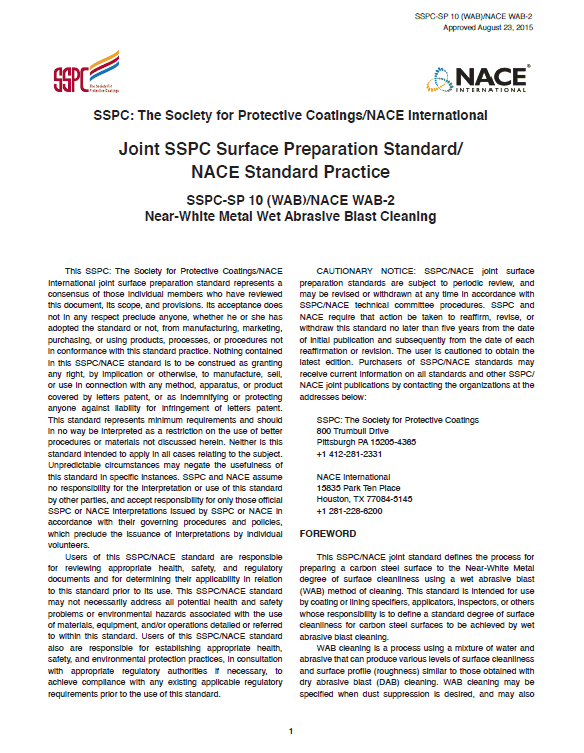New SSPC/NACE wet abrasive blast cleaning (WAB) standards were approved in August 2015. The standards define five degrees of cleaning that are created using a mixture of abrasive and water. The mixture is created in one of three ways: water is injected into the dry abrasive blast stream, abrasive is injected into a pressurized water stream, or an abrasive/water slurry is propelled through the blast hose.
The five degrees of cleaning are titled and numbered the same as dry abrasive blast cleaning, but with a “WAB” suffix:

White Metal WAB SSPC-SP5 (WAB)/NACE WAB-1
Near-White Metal WAB SSPC-SP10 (WAB)/NACE WAB-2 (Fig. 1)
Commercial WAB SSPC-SP6 (WAB)/NACE WAB-3
Industrial WAB SSPC-SP14 (WAB)/NACE WAB-8
Brush-Off WAB SSPC-SP7 (WAB)/NACE WAB-4
The degrees of cleaning in terms of percentage of material or staining allowed to remain on the surface are identical to their dry blast counterparts, but there is one significant difference – flash rust. Flash rust is oxidation that forms on a carbon surface as the water that is used as part of the cleaning process dries. Flash rust will typically show within 30 minutes as drying occurs. The color will vary based on time of wetness and the age and composition of the steel. The standards state that the flash rust will generally change from a yellow-brown, well-adherent light rust to a red-brown, loosely-adherent heavy rust.
NOTE: Flash rust is not included in the dry blast standards since the surface remains dry for the entire process. The dry blast standards discuss freedom from rust back (re-rusting), which is rusting that forms when dry blast cleaned steel is exposed to moisture, contamination, or a corrosive atmosphere. The dry blast standards require the removal of visible rust that forms on the surface after cleaning (i.e., removal of the rust back).
The wet blast standards include provisions for the specifier to define the extent of flash rust that is permitted to form on the surface prior to painting. There are four degrees:
No flash rust – no rusting is visible when viewed without magnification.

Light flash rust rusted surface – small quantities of a rust layer through which the carbon steel is visible when viewed without magnification. It can be evenly distributed or in patches. It is tightly adherent and not easily removed by lightly wiping with a cloth.
Moderate flash rust rusted surface– a rust layer through which the carbon steel is obscured when viewed without magnification. It can be evenly distributed or in patches. It is reasonably well adherent, but leaves light marks on a cloth that is lightly wiped over the surface.
Heavy flash rusted surface – a heavy rust layer through which the carbon steel completely hidden when viewed without magnification. It can be evenly distributed or in patches. It is loosely adherent, easily removed, and leaves significant marks on a cloth that is lightly wiped over the surface.
SSPC-VIS 5/NACE VIS 9, “Guide and Reference Photographs for Steel Surfaces Cleaned by Wet Abrasive Blast Cleaning” shows a few examples of both Commercial and Near-White Wet Abrasive Blast Cleaning as well as the appearance of light, moderate, and heavy flash rust (Figure 2).
The degree of flash rusting that forms on a surface can be reduced by drying the surface quickly after preparation, by adding an inhibitor to the water, or spraying an inhibitor onto the surface immediately after cleaning. The specifier should define the level of flash rust permitted, if any, and whether the use of an inhibitor is allowed. The coating manufacturer should be involved in this decision.





I know there are products that can be introduced into the water stream to keep the steel from rusting. My question is can chlo*rid also be introduced into the water stream at the time of blasting using the hold tight or some other product?
Greg, thanks for your question. The following is a response from Ken Trimber:
Similar to inhibitors, Chlor-rid can be added to the blasting water or to the rinse water. Depending on the severity of the salt contamination and the dwell time required for cleaning, if there’s enough flushing of the surface with water you may not need Chlor-rid. It’s best to do a test blast using just water before production work begins (note that’s water alone – not water with inhibitor). If unacceptable levels of salt remain, Chlor-rid can tell you whether the standard mix ratios will be suitable or if they should be changed.
Greg, again, from Ken Trimber:
I’ve not heard of Chlor-rid and an inhibitor being added together in the water. My initial reaction is that I would be concerned that the inhibitor could potentially mask any remaining chloride from being detected. Chlor-Rid sells an inhibitor called Hold-Blast, so they should be able to answer your question about adding Chlor-rid to it, or if it’s even necessary to use both.
It has got difference, that’s what the word professional means has to be perfectly perfect. This blog was really very informative and really helped me understand what actually was my query. Thanks a lot, keep updating us with further informations.